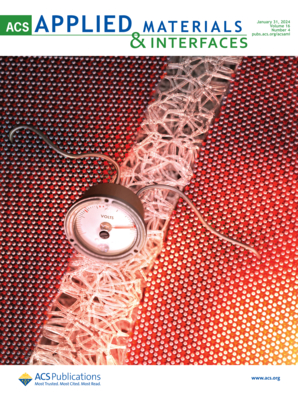3D Network Spacer-Embedded Flexible Iontronic Pressure Sensor Array with High Sensitivity over a Broad Sensing Range
IF 8.3
2区 材料科学
Q1 MATERIALS SCIENCE, MULTIDISCIPLINARY
引用次数: 0
Abstract
Microstructure construction is a common strategy for enhancing the sensitivity of flexible pressure sensors, but it typically requires complex manufacturing techniques. In this study, we develop a flexible iontronic pressure sensor (FIPS) by embedding an isolated three-dimensional network spacer (3DNS) between an ionic gel and a flexible Ti3C2Tx MXene electrode, thereby avoiding complex microstructure construction techniques. By leveraging substantial deformation of the 3DNS and the high capacitance density resulting from the electrical double layer effect, the sensor exhibits high sensitivity (87.4 kPa–1) over a broad high-pressure range (400–1000 kPa) while maintaining linearity (R2 = 0.998). Additionally, the FIPS demonstrates a rapid response time of 46 ms, a low limit of detection at 50 Pa, and excellent stability over 10 000 cycles under a high pressure of 600 kPa. As practical demonstrations, the FIPS can effectively monitor human motion such as elbow bending and assist a robotic gripper in accurately sensing gripping tasks. Moreover, a real-time, adaptive 7 × 7 sensing array system is built and can recognize both numeric and alphabetic characters. Our design philosophy can be extended for fabricating pressure sensors with high sensing performance without involving complex techniques, facilitating the applications of flexible sensors in human motion monitoring, robotic tactile sensing, and human–machine interaction.

三维网络间隔嵌入式柔性离子压力传感器阵列,在宽传感范围内具有高灵敏度
微结构构造是提高柔性压力传感器灵敏度的常用策略,但通常需要复杂的制造技术。在本研究中,我们通过在离子凝胶和柔性 Ti3C2Tx MXene 电极之间嵌入隔离的三维网络间隔(3DNS),开发出了柔性离子电子压力传感器(FIPS),从而避免了复杂的微结构构建技术。通过利用 3DNS 的大幅变形和电双层效应产生的高电容密度,该传感器在较宽的高压范围(400-1000 kPa)内表现出较高的灵敏度(87.4 kPa-1),同时保持线性度(R2 = 0.998)。此外,FIPS 还具有 46 毫秒的快速响应时间、50 帕的低检测限以及在 600 千帕高压下 10 000 次循环的出色稳定性。在实际应用中,FIPS 可以有效监测肘部弯曲等人体运动,并协助机器人抓手准确感知抓取任务。此外,我们还建立了一个实时、自适应的 7 × 7 传感阵列系统,可以识别数字和字母字符。我们的设计理念可扩展用于制造具有高传感性能的压力传感器,而无需涉及复杂的技术,从而促进了柔性传感器在人体运动监测、机器人触觉传感和人机交互方面的应用。
本文章由计算机程序翻译,如有差异,请以英文原文为准。
求助全文
约1分钟内获得全文
求助全文
来源期刊

ACS Applied Materials & Interfaces
工程技术-材料科学:综合
CiteScore
16.00
自引率
6.30%
发文量
4978
审稿时长
1.8 months
期刊介绍:
ACS Applied Materials & Interfaces is a leading interdisciplinary journal that brings together chemists, engineers, physicists, and biologists to explore the development and utilization of newly-discovered materials and interfacial processes for specific applications. Our journal has experienced remarkable growth since its establishment in 2009, both in terms of the number of articles published and the impact of the research showcased. We are proud to foster a truly global community, with the majority of published articles originating from outside the United States, reflecting the rapid growth of applied research worldwide.
 求助内容:
求助内容: 应助结果提醒方式:
应助结果提醒方式:


